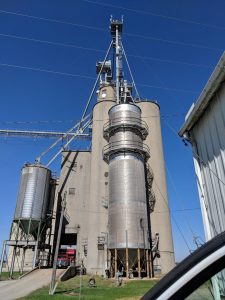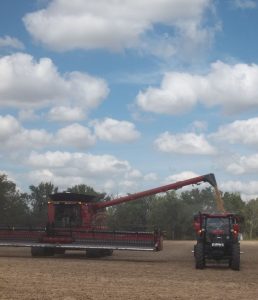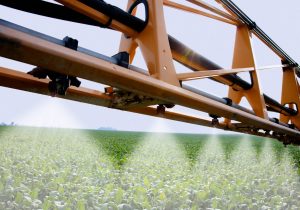Agronomy, Homepage Slider, New Uses, Specialty
Growing a crop for a specialty market
By Dusty Sonnenberg, CCA, Ohio Field Leader: a project of the Ohio Soybean Council and soybean checkoff.
When farmers look for new markets, and ways to receive a premium for their crop production, one option is growing an identity preserved (I.P.) crop. “If you are growing a non-patented seed, you are actually raising an I.P. product that you could be paid a premium for,” said Fred Pond, of Pond Seeds in Van Wert County. “Seed production for larger companies is typically in the “I” states (Iowa, Illinois, and Indiana) and already established, however smaller companies may be interested in contracting with local growers.”

“When farmers consider business agreements to contract the production of I.P. crops, it is important to understand why the buyer is paying a premium for the product they are raising,” said Pond. “It helps to understand the risk and better calculate the costs and returns accurately.”
Premiums paid to growers can be based on several factors. “Some I.P. crops can have lower yields than similar non-I.P. crops,” said Pond. “There are also identity preservation separation requirements.” The separation requirements can extend beyond the stored crop in a separate bin. Identity preservation can also include field boarders or buffer areas that cannot be planted, or if planted, cannot be harvested. It is common for an outside inspector to visit the site throughout the growing season.
Having additional harvest and storage costs should be factored into I.P. crop production budgets. “It is important to remember that seed producer contracts do not want any heat used on seed beans,” said Pond. “There may also be additional equipment that needs to be purchased. Many seed companies like growers to use belt conveyors versus auger systems to protect the seed quality.” There may also be additional time and cost in applying fungicides, combine set-up and also clean-out, as well as equipping storage bins with slotted floors for aeration purposes.
Understanding where delivery locations are and how pricing works, such as CBOT or local elevator prices is an important consideration.
There are often specific planting dates and replant seed contract restrictions. “Often farmers want to plant earlier for a higher yield,” said Pond. “With soybean seed production, the earlier planting produces seed that has lower quality, and there is also a greater risk of frost damage or crop loss. This is a problem when there may be limited seed available for replant.”
If the crop is to be grown organically, there will be additional requirements, such as specific fertilizer products that cannot be used, and added tillage and weed control costs versus a traditional chemical program.
Getting a contract
Most contracts are offered through a local seed business. Other options would be a grain facility that has a market for a specialty commodity. Bunge is one example of this. OSU Extension often makes information available about new crop opportunities in Ohio. As a general rule, the larger agricultural companies do not do local seed production.
Equipment requirements
Most IP contracts are very specific about the delivery and product quality requirements. “It is not uncommon or an IP contract to have a zero tolerance for contamination from other crop seed,” said Pond. “Contracts will detail clean-out IP requirements for planting, harvesting, transportation, storage equipment.  This would include wagons, semi, unloading augers, grain systems and bins. Combine clean-out can be a 2-3 hour job. It includes cleaning out the feeder house, concave, rock trap, anywhere grain can get caught.”
This would include wagons, semi, unloading augers, grain systems and bins. Combine clean-out can be a 2-3 hour job. It includes cleaning out the feeder house, concave, rock trap, anywhere grain can get caught.”
Moisture is something often not considered by farmers when evaluating a contract. The harvest moisture and monitoring changes moisture levels during the day can be critical,” said Pond. “The ground conditions may be great, but if the grain moisture gets too low, harvest may need to stop until the moisture is right, especially for soybeans.”
Field inspections
Many crops require field inspections by outside agencies. One common group is the Ohio Seed Improvement Association. The inspections could occur at flowering, or as a mature crop inspection. Typically, the I.P. contractor and inspector will need field maps. There are often harvest restrictions and set asides. They may also require greater buffers based on what the neighbors plant.
Contracts can also have herbicide restrictions. “Farmers may be required to use specific herbicides and insecticides, or they could be prohibited from using a specific product,” said Pond. “There are also preharvest windows and issues with timing for ideal harvest for the seed or food value of the crop to consider, versus waiting for the harvest window and harvest later. It is important to think about if a fungicide or insecticide application is necessary to maintain quality, but still fit in the harvest window. This is especially a concern for food grade products. Sometimes there is not a good choice.”
Field Preparations and Planting
Identity preserved contracts can be very specific about how and where a crop is grown. “Farmers may be required to report a previous crop that was in a select field. As an example, farmers often cannot plant soybeans behind soybeans due to possible volunteer contamination,” said Pond. “They may be required to plant at a later date to lessen replant risk or increase germination of the new crop. There can be herbicide requirements, and setback distances from other crops as specified. As an example, Hemp can have up to a 3-mile set-back from other hemp fields. Organic considerations also need to come into play for fertility and weed management.
Growing Season
The contracts will give details about in-season crop management. “Each crop will have an approved weed level by type and amount,” said Pond. “There will be field inspections to evaluate disease levels, such as head scab or Phomopsis in beans. The timeliness of making an application to manage a disease or other pest can be critical. The joke is that Barley always needs sprayed on Sunday at 10:00 in the morning because there is a big rain in the forecast.  While it is not always the case, making sure that the options are in place either from a custom applicator, or a farmer having their own equipment is necessary. Crops like barley need monitored, especially around flowering and when weather concerns need monitored so a potential spray window is not missed.”
While it is not always the case, making sure that the options are in place either from a custom applicator, or a farmer having their own equipment is necessary. Crops like barley need monitored, especially around flowering and when weather concerns need monitored so a potential spray window is not missed.”
Harvest
Attention to detail at harvest includes more than just when the crop is at the correct moisture. “All harvest equipment needs to be thoroughly cleaned prior to harvesting the I.P field,” said Pond. “Adjustments may be needed to the combine in the field to protect the seed quality.”
Preparing storage facilities is also important in advance. This can include applying insecticide or fumigation to the storage facility. Crop moisture does need monitored to deliver what the end user wants. “Often moisture can be managed using air versus adding heat. It just depends on the weather and contract details,” said Pond. “Don’t expect to be able to harvest early in order to get in a double crop after the I.P. crop.”
Storage and Delivery
Many of the same factors considered during I.P. crop production pertains to the crop storage and delivery. “It is important to keep crop at the correct specified moisture,” said Pond. “Monitor potential insects while the grain is in storage, and be sure to clean delivery equipment prior to use.”